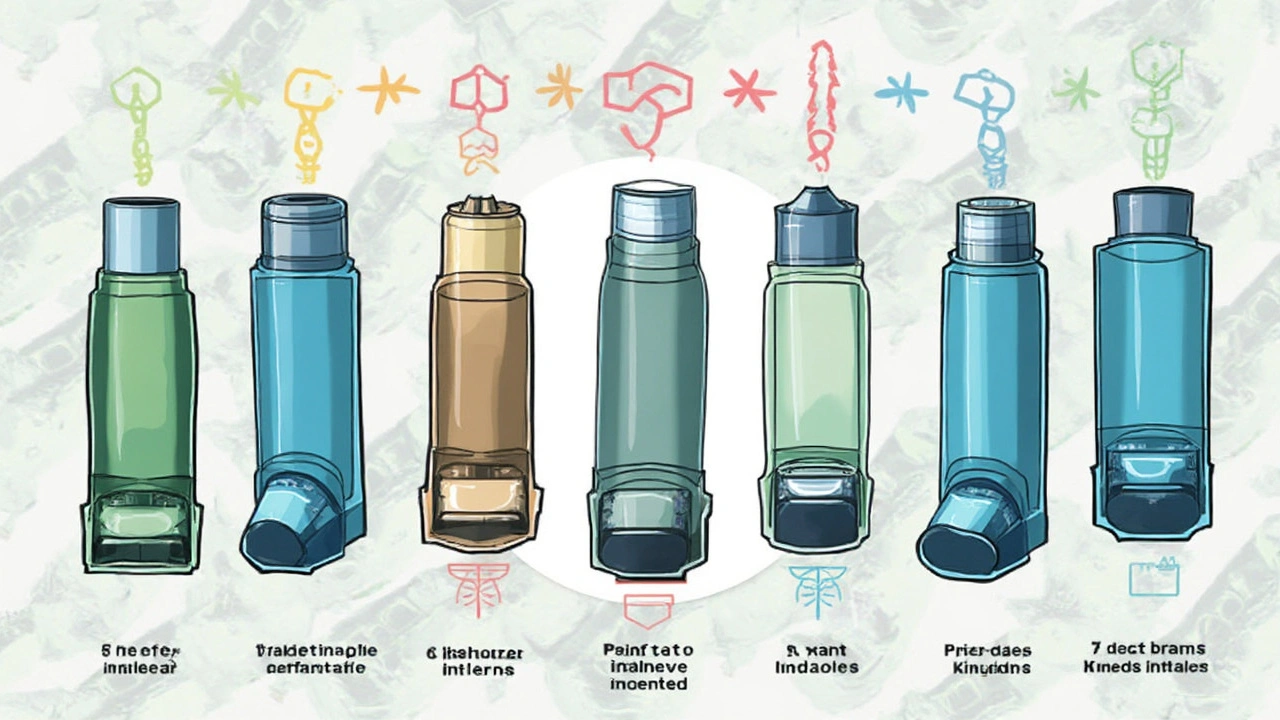The price tag for asthma inhalers can feel like a punch to the gut. You walk into the pharmacy, prescription clutched in hand, hoping the bill won’t sting as hard as your last attack. Then you see the cost: $350, $400, sometimes even more for a single Symbicort inhaler. How is anyone supposed to breathe easy with that kind of stress on top of asthma?
You’re not alone in this. Prescription drug prices in the US have soared in recent years, and asthma meds are a huge part of that painful trend. But here’s the thing: Symbicort isn’t the only option. There are at least seven other proven inhalers—generic and brand-name alike—that help keep asthma and COPD in check for a lot less money. And guess what? Many people actually control their symptoms just as well using these alternatives, while shelling out hundreds less per year.
Ready to stop overpaying and start breathing freely? Here’s the deep dive—with solid facts and practical tips for scoring affordable asthma treatment in 2025.
Why Is Symbicort So Expensive—and What Makes an Inhaler ‘Cheaper’?
First, let’s pull back the curtain on how prices got this high. Symbicort, combining budesonide and formoterol, has been a game-changer for asthma since it hit US markets in 2006. But because AstraZeneca held exclusive patent rights, competition was scarce. Generic versions only appeared in the US recently, while much of the world’s been using generics for years with zero issues. Even now, the brand’s marketing muscle and insurance loopholes keep prices elevated—especially for those without top-tier coverage.
You’ve likely heard stories from friends or family in other countries paying a fraction of what you do. In Canada and Australia, a month’s supply costs under $40. Compare that to the States, where a typical cash price for a single inhaler hovers around $330—even after the first generics launched. Something’s broken here, no doubt about it.
So what defines a “cheaper” alternative? It’s not just about slapping on a low sticker price. You want an inhaler that matches Symbicort’s effectiveness (controlling both baseline inflammation and sudden symptoms), sticks to established guidelines, and fits your budget. Generics are the first place people look, but lower-cost brands, pharmacy discount programs, and even older meds with solid reputations can help, too.
One key thing to remember: The FDA holds generics to the same safety and strength standards as name-brand meds. That means the active ingredients are identical and you’re not short-changing your lungs by switching. In fact, thousands of doctors across the country now suggest switching from costly brands to generics as the first step when asthma care gets too pricey.

7 Cheaper Alternatives to Symbicort That Work in 2025
Okay, so what are your real choices? I’ve pulled the most reliable options together below, split between generics and non-Symbicort brands. This list isn’t pie-in-the-sky theory—these are meds people actually use every day, with real pharmacist and patient feedback.
| Alternative | Active Ingredients | Usual Monthly Cost (Without Insurance) | Notes |
|---|---|---|---|
| Budesonide/Formoterol (Generic Symbicort) | Budesonide + Formoterol | $115–$180 | First-choice generic, matches Symbicort exactly |
| Advair Diskus (Generic: Fluticasone/Salmeterol) | Fluticasone + Salmeterol | $70–$140 | Massively prescribed, effective for moderate/severe asthma |
| Dulera | Mometasone + Formoterol | $150–$200 | Often discounted, similar action to Symbicort |
| Breo Ellipta | Fluticasone + Vilanterol | $140–$190 | Once-daily dosing, increasingly popular |
| Flovent HFA (Generic: Fluticasone) | Fluticasone | $95–$150 | Steroid-only, add an albuterol rescue inhaler as needed |
| Qvar RediHaler | Beclomethasone | $70–$125 | Gentle on the throat, suitable for kids/adults |
| Pulmicort Flexhaler | Budesonide | $65–$135 | Another steroid-only option, proven track record |
Notice how almost every option has a generic—or will soon. That’s where you unlock big savings. For example, the FDA approved generic Symbicort (budesonide/formoterol by Viatris & Kindeva) in March 2022, and it’s finally making a dent in prices at major pharmacies in 2025. Pharmacies like CVS and Walgreens are often pricing the generic at 30-40% less than the brand, and GoodRx coupons or discount apps can bring it even lower.
And that’s not all—Advair Diskus, once seen as the “old school” workhorse, now costs even less since multiple generics hit the shelves. The US is finally catching up to Europe, where generics have driven prices down for over a decade. It’s also worth noting that medications like Flovent and Pulmicort (inhaled steroids without a long-acting bronchodilator) can do wonders for people with mild-to-moderate asthma, as long as you keep a rescue inhaler handy for flare-ups.
Dulera and Breo Ellipta are sometimes seen as luxury picks when insurance covers them, but they pop up in coupon savings programs and manufacturer assistance deals all the time. More folks are asking about Qvar (beclomethasone), a gentle inhaler with few side effects, especially when mouth sensitivity or throat irritation is a problem.
For a deep dive comparing side effects, pricing, and program links, check out these cheaper alternatives to Symbicort which pulls together fresh 2025 info and more patient reviews.
Now, are these all “one-size-fits-all”? Of course not. Asthma is personal, and what keeps you breathing easily might not be perfect for your neighbor. But for anyone whose only barrier to good control is that daunting price tag, these alternatives are game-changers. Conversations with doctors are shifting—saving money is now a legit part of everyday asthma care discussions.

How to Save Even More: Real-Life Tips for Getting the Best Price on Asthma Meds
You’ve seen the scary numbers on those little pharmacy slips. But there are ways to outsmart the system—including a few most people don’t even try. Here’s how actual folks are keeping more cash while still getting the best asthma control. There’s no magic bullet, just a handful of smart moves that add up:
- Ask for generics first. Doctors sometimes default to brands unless you speak up. Request the generic by name (budesonide/formoterol for Symbicort) in your appointment, and check which local pharmacies carry it. Sometimes smaller chains or independent stores offer better cash prices.
- Use online coupon and discount card sites before filling a prescription. GoodRx, SingleCare, and WellRx can slice costs on both brand and generic inhalers. Savings of $50–200 per script are common, especially for big-ticket combo inhalers.
- If you have insurance, double-check your plan’s preferred formulary. Some plans “prefer” one inhaler brand over another, which can make a $300 drug cost only $30. But those deals change every year as insurers make new deals with drug makers.
- See if you qualify for manufacturer assistance programs. Most brand inhalers (including Symbicort, Dulera, Breo, and Advair) have forms you can fill out online for copay cards, free starter packs, or even free annual supply if your income is below a certain threshold.
- Don’t be afraid to switch between brands if your insurance shifts their coverage in January. Switching from Symbicort to Advair or Breo is common and supported by national asthma guidelines.
- Check local independent pharmacies. National chains buy in bulk, but local pharmacies sometimes negotiate special prices with regional suppliers—especially for generics. Get price quotes from two or three nearby stores before filling refills.
- Teleheath and mail-order pharmacies are growing fast in 2025. Companies specializing in respiratory meds sometimes offer prices 10–30% lower than walk-in drugstores, especially for generic combos.
- If you’re traveling or have a friend in Canada, compare international pharmacy prices. While importing personal medication technically has rules, the FDA rarely cracks down on 90-day supplies for personal asthma use. Always source through accredited sellers with pharmacist support.
Want to see how much you can really save? Here’s a snapshot of real prices in 2025 at popular US outlets:
| Medication | CVS Price | Walmart Price | GoodRx/Online Discount |
|---|---|---|---|
| Symbicort (Brand) | $349 | $345 | $295–$330 |
| Budesonide/Formoterol (Generic) | $128 | $119 | $105–$120 |
| Advair Diskus (Generic) | $90 | $86 | $70–$105 |
| Dulera | $197 | $169 | $123–$180 |
| Breo Ellipta | $171 | $159 | $135–$165 |
No one should have to worry about affording to breathe. Yet for so many Americans, the price at the counter is the true health crisis. The tide’s turning, though—generics are cropping up, discount programs are getting easier to use, and people are realizing they don’t have to just accept whatever the insurer says. Talk to your doctor, share your concerns, and don’t stop until you find the cheaper alternatives to Symbicort that fit you, not the drug company’s bottom line. Healthy lungs are worth the effort, and your bank account will breathe easier, too.


Dan Dawson
June 3, 2025 AT 20:50Generic inhalers save you a ton of cash.
Lawrence Jones II
June 8, 2025 AT 11:57The pharmacoeconomic data shows a clear cost‑benefit ratio for budesonide/formoterol generics 📊. Bioequivalence studies confirm identical plasma concentration curves, so efficacy isn’t compromised. From a formulary standpoint, the FDA’s ANDA pathway guarantees the same active ingredient purity. If you leverage GoodRx or SingleCare, the net out‑of‑pocket can drop by up to 70% 😎. Bottom line: you can maintain guideline‑directed therapy without draining your bank account.
Robert Frith
June 13, 2025 AT 03:03Yo, this whole Symbicort price game is a blatant rip‑off by the Americann pharma cartel. The govvvt only lets them keep the monopoly alive while our wallets bleed. People in Canada pay pennies and they get the same relief – why are we forced to fork over a small fortune? Wake up, folks, it’s a war on our lungs and our wallets.
Albert Gesierich
June 17, 2025 AT 18:10Just a quick note on terminology: the article correctly uses “budesonide/formoterol” but refers to “Symbicort” as a generic, which is inaccurate – Symbicort is the brand name. The FDA-approved generic is simply listed as budesonide/formoterol inhalation powder. Precision matters, especially when patients compare formularies. Also, “cost‑effective” should be hyphenated.
Brad Tollefson
June 22, 2025 AT 09:17It’s worth noting that inhaler technique can affect dose delivery, so when switching to a generic you might need a brief re‑training session with your pharmacist. The device resistance for the dry‑powder version is comparable to the brand, but the spray‑dry method varies slightly. Overall, the clinical outcomes remain on par when patients adhere correctly. Small typo alert – “inhaler’s” should be “inhalers”.
Paul van de Runstraat
June 27, 2025 AT 00:23Great rundown! It’s funny how many people assume the pricey brand is the only safe option – surprise, the generics are just as solid. If you’re lucky enough to have a copay card, you might even get a brand for the same price as a generic. Keep sharing these tips, it helps the whole community breathe easier.
Suraj Midya
July 1, 2025 AT 15:30The pharmaceutical industry often puts profit above patient well‑being, and asthma inhalers are a prime example. By exploiting patent extensions and exclusive formularies, they keep essential medicines out of reach for many. It’s a moral failing when a life‑saving device costs more than a month’s rent. Advocacy for transparent pricing is not just idealistic – it’s a necessity.
ashish ghone
July 6, 2025 AT 06:37Hey there, I totally get how overwhelming the price tags can feel – it’s like the system is yelling at you while you’re already gasping for air. First off, remember that the FDA requires generics to meet the exact same standards for dosage, purity, and delivery mechanism, so you’re not compromising on health when you switch. Many patients report the same level of symptom control after moving to a budesonide/formoterol generic, which means you’re still hitting both the anti‑inflammatory and bronchodilator pathways that your lungs need. One strategy that’s helped a lot of folks is to coordinate with a pharmacy that offers a discount program; GoodRx, SingleCare, and even some insurance‑specific portals can shave off $50‑$200 per inhaler. 🤑 Secondly, don’t underestimate the power of a good “talk to your doctor” session – let them know the financial strain you’re under, and ask them to write the prescription for the generic name rather than the brand. That tiny change can trigger the pharmacy’s formulary to prioritize the cheaper option automatically. 📋 Third, consider mail‑order or telehealth pharmacy services; they often have bulk‑pricing agreements that can drop the price another 10‑15% compared to a brick‑and‑mortar store. Fourth, if you have a flexible spending account (FSA) or health savings account (HSA), you can use those pre‑tax funds to offset the cost even further. Fifth, keep an eye on manufacturer assistance programs – many inhaler makers offer copay cards or free starter packs for patients who meet income criteria, and these programs are sometimes hidden in the fine print of the drug’s official website. Finally, don’t forget to look into community health clinics; some of them have partnerships with local pharmacies and can offer inhalers at a sliding‑scale fee or even for free. Remember, you deserve to breathe without watching your bank account spiral. Keep pushing, keep asking questions, and keep sharing these hacks – the more we talk about it, the louder the call for affordable asthma care becomes. 🌟
steph carr
July 10, 2025 AT 21:43Loved the comprehensive list – it makes the decision process way less intimidating. It’s reassuring to see that there are solid alternatives that won’t break the bank, especially for folks juggling multiple prescriptions.
Vera Barnwell
July 15, 2025 AT 12:50There’s a hidden agenda here: big pharma has been colluding with insurance companies to keep the prices of combo inhalers artificially high. The “generic” rollout is actually a controlled experiment to see how low they can push the price before the market reacts. Some insiders claim that the data from these trials is fed directly into policy decisions, ensuring that even the “cheaper” options stay well above what a truly competitive market would dictate. It’s a classic case of manufactured scarcity, and the public is left holding the bill. Stay vigilant.
David Ross
July 20, 2025 AT 03:57It’s fantastic to see such a thorough breakdown, especially with the inclusion of price‑comparison tables, because those numbers really help us visualize the savings, and the actionable tips, like checking pharmacy discount apps, negotiating with local pharmacists, and exploring tele‑health options, are all things we can start doing right now, which means we don’t have to feel stuck with sky‑high costs any longer.
Henry Seaton
July 24, 2025 AT 19:03Look, if you want to keep paying $350 for a brand, go ahead, but most of us just want a decent price.
Baby Thingie
July 29, 2025 AT 10:10According to FDA guidelines, generic inhalers must demonstrate bioequivalence to their brand counterparts. ✅
Abby Elizabeth
August 3, 2025 AT 01:17OMG this article is soooo boring, like who even reads this stuff? I’m over it.
Mark Haycox
August 7, 2025 AT 16:23The data clearly indicates a systematic overpricing scheme orchestrated by domestic pharmaceutical conglomerates, and any claim otherwise is pure propaganda spouted by the industry lobby.
Michael Taylor
August 12, 2025 AT 07:30What a relief to find such a detailed post, because navigating the maze of inhaler costs can be downright exhausting, especially when you’re juggling appointments, insurance paperwork, and the daily struggle of managing asthma symptoms; the tables, the tips, the brand‑vs‑generic breakdown-all of it serves as a roadmap that guides us, step by step, toward more affordable, yet equally effective treatment options, and that, my friends, is exactly the kind of empowerment we need in today’s healthcare landscape.
Troy Brandt
August 16, 2025 AT 22:37I completely agree with the earlier point about checking discount programs, and I’d add that many patients overlook the importance of synchronizing refill dates across all their inhalers to maximize mail‑order savings; by aligning your refill schedule, you not only reduce the risk of missed doses but also often qualify for bulk‑order rebates that can further lower the overall cost, which is a win–win for both adherence and your wallet.
Barbra Wittman
August 21, 2025 AT 13:43Nice work on the comprehensive guide, but let’s be real-most of us just want a cheap inhaler without having to read a novella. If you can condense the key steps into a quick‑look checklist, you’ll actually help people who are already drowning in medical jargon.
Gena Thornton
August 26, 2025 AT 04:50In summary, there are multiple FDA‑approved generic alternatives to Symbicort that provide comparable clinical outcomes at a fraction of the cost; leveraging discount apps, checking formulary preferences, and exploring manufacturer assistance programs are practical ways to reduce out‑of‑pocket expenses while maintaining optimal asthma control.